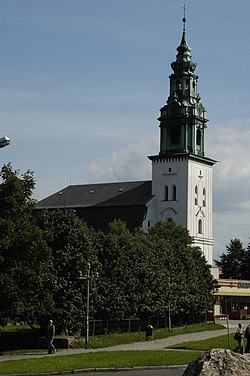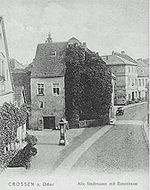This is an old revision of this page, as edited by 87.188.213.1 (talk) at 18:11, 3 August 2011 (→Notable people). The present address (URL) is a permanent link to this revision, which may differ significantly from the current revision.
Revision as of 18:11, 3 August 2011 by 87.188.213.1 (talk) (→Notable people)(diff) ← Previous revision | Latest revision (diff) | Newer revision → (diff)- Not to be confused with Krosno in the Subcarpathian Voivodeship
| Krosno Odrzańskie | |
|---|---|
 Parish Church (Fara) Parish Church (Fara) | |
 Coat of arms Coat of arms | |
| Country | |
| Voivodeship | Lubusz |
| County | Krosno Odrzańskie County |
| Gmina | Gmina Krosno Odrzańskie |
| Town rights | before 1238 |
| Government | |
| • Mayor | Marek Cebula |
| Area | |
| • Total | 8.11 km (3.13 sq mi) |
| Highest elevation | 85 m (279 ft) |
| Lowest elevation | 38 m (125 ft) |
| Population | |
| • Total | 12,100 |
| • Density | 1,500/km (3,900/sq mi) |
| Time zone | UTC+1 (CET) |
| • Summer (DST) | UTC+2 (CEST) |
| Postal code | 66-600 to 66-603 |
| Area code | +48 68 |
| Car plates | FKR |
| Website | http://www.krosnoodrzanskie.pl |
Krosno Odrzańskie (Template:Lang-de) is a city on the east bank of Oder River, at the confluence with the Bóbr. The town in Western Poland with 12,500 inhabitants (2002) is the capital of Krosno County. It is assigned to the Lubusz Voivodeship (since 1999), previously part of Zielona Góra Voivodeship (1975–1998).
History
The town was first mentioned as Crosno in 1005, when Duke Bolesław I Chrobry of Poland had a fortress built here in the course of his armed conflict with Emperor Henry II and the West Slavic Veleti confederation. Due to its strategic location, it played an important role at the western border of the Polish kingdom with the Holy Roman Empire during the 11th to 13th centuries. In 1163 Krosno was part of the Duchy of Silesia ruled by Bolesław I the Tall of the Silesian Piasts at Wrocław. In 1201 it received its town charter by Bolesław's son Duke Henry I the Bearded. Henry erected a stone castle at Krosno, where he died in 1238 and where his widow, Hedwig of Andechs, took refuge during the 1241 Mongol invasion of Europe. When the Duchy of Wrocław was finally divided in 1251, the town became part of the newly created Duchy of Głogów under Konrad I.

The town changed hands several times; once it was given as payment to soldiers of the Ascanian margraves of Brandenburg. When the last Piast duke Henry XI of Głogów died without issue in 1476, his widow Barbara of Hohenzollern, daughter of Elector Albert Achilles of Brandenburg, inherited the territory of Crossen. The Brandenburg influence met with fierce opposition by Henry's cousin Duke Jan II the Mad of Żagań, who devastated Krosno but in 1482 had to sign an agreement with Albert Achilles, who was able to retain the Krosno area. As a former part of the Duchy of Głogów it officially remained a lien of the Bohemian kingdom until in 1538 King Ferdinand I of Habsburg, renounced all rights to Crossen in 1538, thereby finalizing the district's belonging to the Neumark region of the Brandenburg margraviate.
With Brandenburg Crossen became part of the Kingdom of Prussia in 1701. In reforms after the Napoleonic Wars, the town became part of the Province of Brandenburg in 1815.
In 1945 during World War II, the town was conquered by the Soviet Red Army. According to the post-war Potsdam Conference, the town east of the Oder-Neisse line was placed under Polish administration. The German-speaking inhabitants were expelled westward and replaced with Poles. Due to war and expulsion, the population was reduced from 10,800 in 1939 to 2,000 in 1946.
Notable people
- Georg Wenzeslaus von Knobelsdorff (1699–1753) painter and architect
- Johann Friedrich Schönemann (1704–1782), theater director
- Christiane Becker-Neumann, (1778–1797), actress
- Eduard Seler (1849–1922), anthropologist, archaeologist, philogian, and Mesoamerica scholar
- Rudolf Pannwitz (1881–1969), author
- Hans Egidi (1890–1976), former president of court
- Alfred Henschke ps.Klabund (1890–1928), author
- Tomasz Kuszczak - Poland national football team and Manchester United goalkeeper
- Aneta Pastuszka - Olympic canoer
Literature
- Crossener Tageblatt (Crossener Wochenblatt) Crossen a.O.: 1826 ff.
- Die Kunstdenkmäler des Kreises Crossen. Hrg. Erich Blunck, bearb. von Wilhelm Jung. Berlin: Voss, 1921 (Die Kunstdenkmäler der Provinz Brandenburg / hrsg. vom Brandenburgischen Provinzialverbande ; Bd. 6, Teil 6)
- Karl von Obstfelder: Chronik der Stadt Crossen. Von den ältesten Zeiten bis zum Jahre 1845 im Auszuge, von 1845 bis 1925 selbständig bearbeitet. Crossen a.O.: Zeidler 1925
- Heimatbuch des Kreises Crossen (Oder). Bearb. u. hrsg. v. Karl Metzdorf. Crossen: Zeidler 1927
- Karl Metzdorf: Die Eindeutschung der Ostmark im Mittelalter. Langensalza: Beltz 1925
- 400 Jahre Realgymnasium Crossen an der Oder. Crossen: Zeidler 1927
- Jan Muszýnski: Krosno Odrzánskie. Lubuskie Towarzystwo Naukowe. Przeszłość i teraźniejszość. Warszawa: PWN 1972 (Die Stadt Crossen a. d. Oder. Vergangenheit und Gegenwart)
- Beata Halicka: Krosno Odrzańskie. Wspólne dziedzictwo kultury / Crossen an der Oder. Das gemeinsame Kulturerbe. 1005–2005, Skórzyn 2005. ISBN 83-922273-0-1
- Heimatkarte des Kreises Crossen a. O., mehrfarbiges Reprint, Niederlausitzer Verlag, Guben. ISBN 3-935881-23-1
External links
- 1615 Map of Brandenburg with Duchy of Crossen on Oder river
- Official town website
- Map via mapa.szukacz.pl
52°03′N 15°05′E / 52.050°N 15.083°E / 52.050; 15.083
| Krosno Odrzańskie County | ||
|---|---|---|
| Seat: Krosno Odrzańskie | ||
| Urban gmina |  | |
| Urban-rural gmina | ||
| Rural gminas | ||
| Gmina Krosno Odrzańskie | ||
|---|---|---|
| Town and seat |  | |
| Villages | ||
Categories: